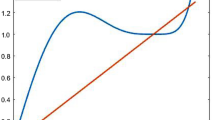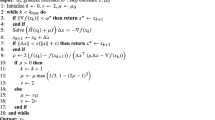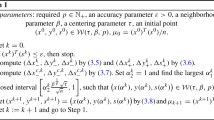Abstract
Computing with guarantees is based on two arithmetical features. One is fixed (double) precision interval arithmetic. The other one is dynamic precision interval arithmetic, here also called long interval arithmetic. The basic tool to achieve high speed dynamic precision arithmetic for real and interval data is an exact multiply and accumulate operation and with it an exact dot product. Pipelining allows to compute it at the same high speed as vector operations on conventional vector processors. Long interval arithmetic fully benefits from such high speed. Exactitude brings very high accuracy, and thereby stability into computation. This document, which has been incorporated into the draft standard for interval arithmetic being developed by IEEE P1788, specifies the implementation of an exact multiply and accumulate operation.
Similar content being viewed by others
References
Lohner R (1993) Interval arithmetic in staggered correction Format. In: Adams E, Kulisch U (eds) Scientific computing with automatic result verification. Academic Press, London, pp 301–321
Blomquist F, Hofschuster W, Krämer W et al (2009) A modified staggered correction arithmetic with enhanced accuracy and very wide exponent range. In: Cuyt A (eds) Numerical validation in current hardware architectures. Lecture notes in computer science LNCS, vol 5492. Springer, Berlin, pp 41–67
Klatte R, Kulisch U, Lawo C, Rauch M, Wiethoff A (1993) C–XSC, A C++ class library for extended scientific computing. Springer, Berlin. See also: http://www.math.uni-wuppertal.de/~xsc/resp; http://www.xsc.de/
Kulisch U (2008) Computer arithmetic and validity—theory, implementation, and applications. de Gruyter, Berlin
The IFIP WG-IEEE 754R letter, dated 4 September 2007
The IFIP WG-IEEE P1788 letter, dated 9 September 2009
IEEE Floating-Point Arithmetic Standard (2008) 754
Neumaier A. Vienna Proposal for Interval Standardization
IBM System/370 RPQ (1984) High accuracy arithmetic. SA 22-7093-0, IBM Deutschland GmbH (Department 3282, Schönaicher Strasse 220, D-71032 Böblingen)
ACRITH-XSC: IBM High Accuracy Arithmetic, Extended Scientific Computation. Version 1, Release 1, General Information (GC33-6461-01), Reference (SC33-6462-00), Sample Programs (SC33-6463-00), How To Use (SC33-6464-00), Syntax Diagrams (SC33-6466-00). IBM Deutschland GmbH (Schönaicher Strasse 220, D-71032 Böblingen), 1990
Rump SM (1980) Kleine Fehlerschranken bei Matrixproblemen. Dissertation, Universität Karlsruhe
Oishi S, Tanabe K, Ogita T, Rump SM (2007) Convergence of Rump’s method for inverting arbitrarily ill-conditioned matrices. J Comput Appl Math 205: 533–544
Author information
Authors and Affiliations
Corresponding author
Additional information
Communicated by G. Alefeld
This document is an identical copy of a motion accepted by the international standards committee IEEE P1788 on interval arithmetic. Its contents will be published in a few years when the development of the standard is completed. The new floating-point arithmetic standard IEEE 754 (available since 2008) provides a function for accumulation of the dot product of two vectors with no accuracy requirement. Manufacturers who support the dot product by hardware should be aware that IEEE P1788 requires the exact result. Once a weak solution has been put into hardware it may be difficult to change it later. It is therefore important to bring this decision to public attention as soon as possible. Actually the simplest and fastest way for computing a dot product is to compute it exactly [4].
Part of this work supported by Institut für Angewandte und Numerische Mathematik, Universität Karlsruhe.
Part of this work supported by NASA at Jet Propulsion Laboratory, California Institute of Technology.
Rights and permissions
About this article
Cite this article
Kulisch, U., Snyder, V. The exact dot product as basic tool for long interval arithmetic. Computing 91, 307–313 (2011). https://doi.org/10.1007/s00607-010-0127-7
Received:
Accepted:
Published:
Issue Date:
DOI: https://doi.org/10.1007/s00607-010-0127-7
Keywords
- Computer arithmetic
- Arithmetic standard
- Exact Dot Product
- Floating-point arithmetic
- Scientific Computing




